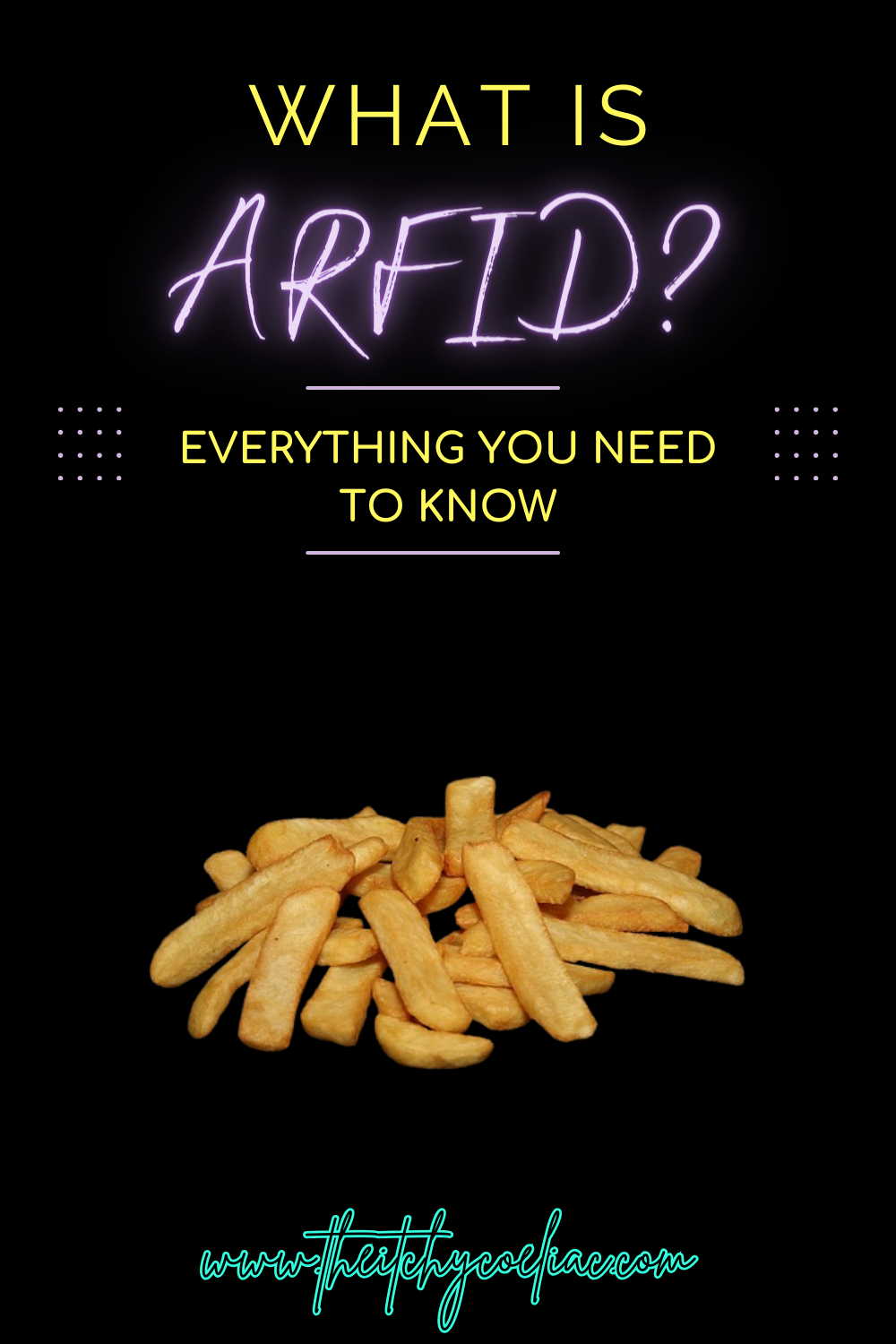Have you spent your life being the kid at the party that didn’t run to the food table? Or is your child the one that will only have a certain brand of crisps? Do you often hear the phrase ‘picky eater’?
That was me for 26 years until I learned about ARFID. What is ARFID? Don’t worry, that’s what this post is for!
I’m going to explain exactly what ARFID is, some of its common symptoms and share some tips and tricks! Plus, let’s take a deeper look into why there is so little awareness surrounding the eating disorder.
Pin it for later!

So what does ARFID mean?
Avoidant Restrictive Food Intake Disorder (or ARFID for short!) is an eating disorder where you avoid certain foods or limit your food intake. Or sometimes both!
There are three main reasons for this and you might relate to just one, two or all three.
- Aversive – You may be fearful of what might happen when you eat and be worried about choking, being sick or contracting an illness from the food. This can come from a traumatic past experience with food or fear of the consequences of eating certain foods.
- Restrictive – You simply have very little or no interest in eating and may often have to be reminded to eat something. Eating can seem like a chore and not a very pleasant experience.
- Avoidant – You have sensory issues when it comes to food that can relate to the taste, smell, or texture of foods.
While these are the three main recognised ‘categories’ of ARFID, it can present itself differently from person to person. So your own experience may look a little different to someone else’s!
I personally find that I am mostly in tune with the third point listed above. But, I know that I also carry certain factors from the other points.
For example, while I don’t have an overwhelming fear of illness from new foods, I do worry a little over if it will make me sick. I have a lot of other food allergies so I’m always questioning trying something new. I’m thinking will this make me ill? (Point 1.)
Another example would be that I’d say I have a pretty large appetite. I mean, a whole pizza in one sitting, plus chips? Not an issue. But, if I’m unsure whether my safe foods are available or if I’m somewhere unfamiliar, I can quite easily go hours without eating or even thinking about eating. And if I do have to think about it, it’s with the thought that it will not be a fun experience. (Point 2.)
ARFID is now a recognised eating disorder which is great! But it’s important to note that ARFID is not related to a person’s body image, unlike other common eating disorders such as Bulimia or Anorexia. Weight loss can be a symptom of ARFID but we are not restricting our food intake with the intention of changing our body image. That being said, other eating disorders can become a symptom of having ARFID.

So what are the symptoms of ARFID?
Avoidant restrictive food intake disorder presents itself differently in pretty much everybody that has it. While there are definitely similarities in the behaviours of those with the disorder, these can vary from person to person.
Some of the more common symptoms might be:
- A lack of interest in food
- Avoiding certain foods due to the texture, smell or appearance
- Refusal to try anything new
- Sticking to their known ‘safe foods’
- Needing to have their food made or laid out in a certain way
- Expressing a fear that if they eat a certain food they might choke or throw up
This is the basics of it but as I mentioned previously, everybody’s ARFID journey is different.
Let me give you some examples of the list above in everyday situations. I think sometimes it helps to put it in perspective better for those who are unfamiliar with ARFID. (These are all based on examples from my life, they’re not universal to all ARFID sufferers!)
Avoiding certain foods
I tend to avoid foods that have a really strong smell. There’s this microwave pasta that my sister likes to make and I always hated it because the smell was so strong. Even without seeing the food, I knew I didn’t want to eat anything like that.
I also avoid anything that is really messy because I don’t like the idea that there will be bits everywhere. For some reason it makes me feel really icky.
Refusing to try new foods
Sooo many arguments in my house as a kid was over my refusal to try new foods. I would point blank refuse and nothing could change my mind. Even when told I couldn’t leave the table and I wouldn’t get anything else – didn’t matter. I’d have sat there for the rest of my life and starved to death.
It was only when I started having food therapy that I began trying new things. Even then it was a struggle, but I managed to try a few new foods for my safe list.
Needing to have food laid out or prepared in a certain way
As a kid, school would report to my mum how strange I acted at dinner times. I had to sit in the same seat, I had to take everything out of my lunch box in the same order and it all had to be eaten in the same order.
Another example was that I wouldn’t allow foods on my plate to touch. If they were touching, I wouldn’t eat them.
These are just a couple of examples of the behaviours someone with ARFID can exhibit. As I said, it does differ from person to person and so one person’s journey with the eating disorder likely will not look like someone else’s.
How do you recover from ARFID?
ARFID recovery is not something that is as simple as ‘here’s a cure, you’re welcome’. There is no one size fits all treatment for ARFID as each individual experiences different symptoms and for different reasons.
For children, different therapies can be helpful in managing their ARFID. Desensitisation therapy is a way of making therapy into more of a ‘play’ experience so the child feels at ease when taking part in exploring new tastes, smells and foods.
Exposure therapy is another commonly used treatment in which they can overcome their fears and feelings towards eating new foods, in a safe environment. It can also include visualisation methods and learning positive coping skills.
ARFID in adults can be treated in a similar way. Therapy like Cognitive Behavioural Therapy (CBT) can be used as a way of talking through the thoughts and feelings they have towards their avoidance or restriction of food.
It’s important that while having treatment for ARFID, that you are also seeing a dietician. You must make sure your body is performing as it should be and getting the things it needs. Most people with ARFID require supplements or extra vitamins that they’re not getting from their diet.

I’m not 100% sure what the therapy was called that I had as a child. I do know that it was helpful!
It allowed me to be heard and for the feelings that I was having to be understood. I was able to open myself up a little and I did try some new foods.
Did it cure me of my ARFID? No. But it did help for sure.
And not only with my own issues but with the direct effect my ARFID was having on family members.
My parents were frustrated with me because of my eating behaviours and it caused more than a few arguments. The therapy was a good way for them to understand what was going on and for us to work together on making it easier as a family.
We weren’t aware then that I had ARFID (it wasn’t really known about when I was younger), just that I was ‘weird’.
One type of treatment may not work across the board for ARFID sufferers. Unfortunately, there haven’t been enough studies into it for one to be created yet. For the moment, it’s all a bit trial and error but hopefully in the future there will be more people looking into ARFID and working out how we can best be helped.
How can you support someone with ARFID?
People with ARFID can oftentimes feel very isolated and like nobody really gets what’s going on with them. It’s so important to be supportive and help with their ongoing journey managing and improving their relationship with food.
Whether it’s your child or an adult in your life who is suffering with ARFID, here’s a few ways you can support them in everyday life.
Don’t push them to try new foods
Pushing hard for someone with ARFID to try new things just makes them feel pressured and stressed because they’re physically not able to do what it is you’re asking. If there’s something new on offer, do not push it on them to try it. Gently encourage and respect their boundaries if they say no.
Make sure they have some of their ‘safe foods’ available
Something that I’ve always found to be really supportive is when a friend or family member has made sure that I have one of my safe foods available. It’s incredibly thoughtful and makes us feel massively at ease because we know it can be a pain.
You can find out more about safe foods in this post here! ‘Safe Foods When You Have ARFID: Junk or a Lifeline?‘
Know that we’re just as frustrated as you are
We know how irritating it can be for other people when dealing with ARFID. It’s difficult to understand and it presents itself in ways that most would consider ‘strange’. Especially for parents of ARFID kids, it can be hard to see your child not hitting their growth milestones or simply not eating.
But we are just as frustrated as you are. We would love to be able to go to a restaurant and order anything and everything. We would love to sit down to a family dinner and just eat. I personally felt so much shame and guilt for the stress I caused my family at meal times. I would get mad with myself for not just being able to eat.
So yes, we understand that it’s frustrating and it can be a pain in the behind but I promise – we’re not doing it intentionally. And all those feelings you’re having, we’re having them too – plus some.
Do not make fun of them
This is one that should be obvious but it does need saying. When someone is struggling with something, making fun of them is not the way to help. We need encouragement and positive reinforcement.
Making fun of someone for an eating disorder can oftentimes make it worse. It can also end up leading to a load of other mental health issues and internalised trauma.
In fact, not making fun of people is just a general rule for life, okay?
Those are just a couple of ways you can support someone who is suffering with ARFID.
For a more in depth look at this topic, check out my post 7 Helpful Ways to Support Someone With ARFID
Why we need more ARFID awareness
You might be reading this and thinking, ‘I’ve never heard of it before’ or ‘is this some new trendy thing’ or ‘is this even real?’.
I wouldn’t be surprised if you were. Until a few years ago, ARFID wasn’t something that was as widely heard of as it is now. It was only recognised as an eating disorder diagnosis in 2013 and there’s been little research into it since then.
Even now there are many medical and healthcare professionals that are unsure what it means. This can make it hard for someone to get an official diagnosis, especially for adults.
More ARFID awareness is needed so that we can stop being labelled as ‘picky eaters’ and so research can be done into finding an effective and specific way to treat ARFID.
We are not just picky eaters or fussy or difficult or spoiled. We are suffering with a life changing disorder that literally affects everything we do.

So now you know what Avoidant Restrictive Food Intake Disorder is. We’ve gone over how it presents itself, what can be done to help, and how to support someone going through it.
Whether you’re suffering with ARFID or someone you know has it, I hope this has been helpful in explaining a bit about it and helps to bring more awareness. If there’s anything else you want to know about ARFID or what it’s like to have it, check out some of my other posts! I have a whole category just for ARFID and my journey with it.
You can also reach out to me on all my social accounts. I love hearing from other people with ARFID and how you’re getting on. And feel free to leave a comment below with any questions you have!





